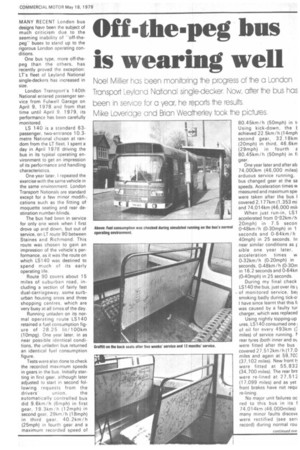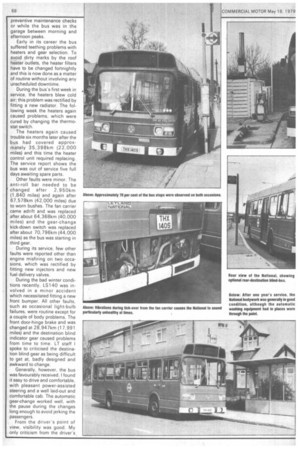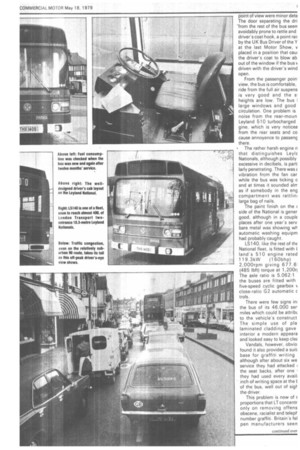Off-the-peg bus is wearing well
Page 69

Page 70

Page 71

Page 72

If you've noticed an error in this article please click here to report it so we can fix it.
Noel Milker has oeen monitoring the progress of the a London Transport Leylanc National single-decker. Now, after the bus has been in service for a year, he reports the results.
Mike Loveridge and Brian Weatherley took the pictures.
MANY RECENT London bus designs have been the subject of much criticism due to the seeming inability of -off-thepeg'' buses to stand up to the rigorous London operating conditions.
One bus type, more off-thepeg than the others, has recently proved the exception: LT's fleet of Leyland National single-deckers has increased in size.
London Transport's 140th National entered passenger service from Fulwell Garage on April 9, 1 978 and from that time until April 9, 1979, its performance has been carefully monitored.
LS 140 is a standard 63passenger. two-entrance 10.3metre National chosen at ran-1 dom from the LT fleet. I spent a day in April 1978 driving the bus in its typical operating environment to get an impression of its performance and handling characteristics.
One year later, I repeated the exercise with the same vehicle in the same environment. London Transport Nationals are standard except for a few minor modifications such as the fitting of moquette seating and rear destination number-blinds.
The bus had been in service for only one week when I first drove up and down, but out of service, on LT route 90 between Staines and Richmond. This route was chosen to gain an impression of the vehicle's performance, as it was the route on which LS140 was destined to spend much of its early operating life.
Route 90 covers about 15 miles of suburban road, including a section of fairly fast dual-carriageway, some surburban housing areas and three shopping centres, which are very busy at all times of the day.
Running unladen on its normal operating route LS140 retained a fuel consumption figure of 28.25 lit/100km (10mpg). One year later, in as near possible identical conditions, the unladen bus returned an identical fuel consumption figure.
Tests were also done to check the recorded maximum speeds in gears in the bus. Initially starting in first gear, although later adjusted to start in second following requests from the
drivers' union, the automatically controlled bus did 9.6km/h (6mph) in first gear, 19.3km /h (12mph) in second gear, 29km/h (18mph) in third gear. 40.2km/ h (25mph) in fourth gear and a maximum recorded speed of
80.45km /h (50mph) in t. Using kick-down, the achieved 22.5km/h (14mph second gear, 32.18km (20mph) in third, 46.6km (29mph) in fourth 80.45km/h (50mph) in fi gear.
One year later and after ab 74,000km (46,000 miles) arduous service running, bus changed gear at the sa speeds. Acceleration times w measured and maximum spe were taken after the bus I covered 2,177km (1,353 mi and 74,014km (46,000 mill When just run-in, LS1 accelerated from 0-32km /h 20mph) in 7.5 secon 0-48km/h (0-30mph) in 1 seconds and 0-64km /h 40mph) in 25 seconds. In near similar conditions as sible one year later, acceleration times w 0-32km/h (0-20mph) in seconds, 0-48km /h (0-30m in 16.2 seconds and 0-64kn (0-40mph) in 25 seconds.
During my final check LS140 the bus, just over its y of monitored service, be smoking badly during tick-o. I have since learnt that this f; was caused by a faulty tur charger, which was replaced
Using nightly topping-up
ures, LS consumed one of oil for every 493km miles) of service running. rear tyres (both inner and ot, were fitted after the bus covered 27,512km /h (17,0 miles and again at 59,70:: (37,102 miles). New front t, were fitted at 55,832 (34,700 miles). The rear bra were re-lined at 27,512 (17,099 miles) and as yet front brakes have not requ re-lining.
No major unit failures oc red to this bus in its 74,014km (46,000miles) many minor faults discov( were rectified (see sen record) during normal rou preventive maintenance checks or while the bus was in the garage between morning and afternoon peaks.
Early in its career the bus suffered teething problems with heaters and gear selection. To avoid dirty marks by the roof heater outlets, the heater filters have to be changed fortnightly and this is now done as a matter of routine without involving any unscheduled downtime.
During the bus's first week in service, the heaters blew cold air: this problem was rectified by fitting a new radiator. The following week the heaters again caused problems, which were cured by changing the thermostat switch.
The heaters again caused trouble six months later after the bus had covered approxmately 35,398km (22,000 miles) and this time the heater control unit required replacing.. The service report shows the bus was out of service five full days awaiting spare parts.
Other faults were minor. The anti-roll bar needed to be changed after 2,950km (1,840 miles) and again after 67,578km (42,000 miles) due to worn bushes. The fan carrier came adrift and was replaced after about 64,368km (40,000 miles) and the gear-change kick-down switch was replaced after about 70,796km (44,000 miles) as the bus was starting in third gear.
During its service, few other faults were reported other than engine misfiring on two occasions, which was rectified by fitting new injectors and new fuel delivery valves.
During the bad winter conditions recently, LS 140 was involved in a minor accident which necessitated fitting a new front bumper. All other faults, such as occasional light-bulb failures, were routine except for a couple of body problems. The front door-hinge brake and was changed at 28,947km (17,991 miles) and the destination blind indicator gear caused problems from time to time. LT staff I spoke to criticised the destination blind gear as being difficult to get at, badly designed and awkward to change.
Generally, however, the bus was favourably received. I found it easy to drive and comfortable, with pleasant power-assisted steering and a well laid-out and comfortable cab. The automatic gear-change worked well, with the pause during the changes long enough to avoid jerking the passengers.
From the driver's point of view, visibility was good. My only criticism from the driver's point of view were minor deta The door separating the dri from the rest of the bus seerr avoidably prone to rattle and driver's coat hook, a point rail by the UK Bus Driver of the Y at the last Motor Show, v placed in a position that cau: the driver's coat to blow ab out of the window if the bus driven with the driver's wind open.
From the passenger poirr view, the bus is comfortable, ride from the full air suspens is very good and the sheights are low. The bus I large windows and good circulation. One problem is noise from the rear-moun Leyland 510 turbocharged gine, which is very noticea from the rear seats and co cause annoyance to passenc, there.
The rather harsh engine n that distinguishes LeylE Nationals, although possibly excessive in decibels, is part larly penetrating. There was E vibration from the fan car while the bus was ticking c and at times it sounded alnas if somebody in the eng compartment was rattlin, large bag of nails.
The paint finish on the side of the National is gener good, although in a couple places after one year's serv bare metal was showing automatic washing equipm had probably caught.
LS140, like the rest of the National fleet, is fitted with I land's 510 engine rated 119.3kW (160bhp) 2,000rpm giving 677.6 (485 lbft) torque at 1,200n The axle ratio is 5.062:1 the buses are fitted with five-speed cyclic gearbox \, close-ratio G2 automatic c trols.
There were few signs in: the bus of its 46,000 ser miles which could be attribt to the vehicle's construct The simple use of pla laminated cladding gave interior a modern appeara and looked easy to keep cleE Vandals, however, obvio found it also provided a suit base for graffiti writing although after about six we service they had attacked , the seat backs, after one they had used every avail, inch of writing space at the t of the bus, well out of sigt the driver.
This problem is now of 5 proportions that LT concentr only on removing offens obscene, racialist and teleplnumber graffiti. Britain's fel pen manufacturers seen
have been successful in developing inks that are resistant to most types of cleaning solvents.
That is, then, a summary of the major events in the first year of service given by Leyland National THX1 40S to the people of Greater London.
It is not often that we have the chance to report on one vehicle covering over 40,000 miles in the hands of many different drivers. Our service records shows that the National lost only 29 days due to faults and 1 0 of these days it was awaiting spare parts (four days for new injectors and five days for a heater control unit) and a further six days due to accident damage.
It performed throughout one of the worst winters in living memory, when roads were not gritted and there were catastrophic numbers of bus breakdowns.
LS14 0 did not lose one day's service through breakdowns throughout the entire winter and caused no problems on the road once initial teething problems were overcome.
Originally bought as shortterm replacements for unexpectedly short-lived vehicles, they are now being bought to overcome slow deliveries in new buses. Yet if LS14 0 continues to perform in the same way, the Leyland National seems one offthe-peg bus which does stand up to LT's requirements. With a passenger carrying capacity of 63, the National can cope with most requirements, which justifies London Transport's increasing the fleet size to almost 400.
Although criticisms take up much of this report, for most of the year there was little to criticise as the bus was quietly operating between 400 and 1,900 service miles a week.
With its pleasant modern looks and serviceable interior, the phase 2 Series-A Leyland National is let down only by minor points such as its destination-blind gear.
Soon to be replaced by the Leyland National Mark 2, it is to be hoped that this newcomer retains the good points of this bus and overcomes these minor everyday problems.
Any bad reputation for problems gained by early Leyland Nationals did not seem at all justified by the performance during one year's operation from London Transport's Fulwell Garage by LS140, which received no more attention than was required or than is normal for buses operating in London Transport service.




















































































































